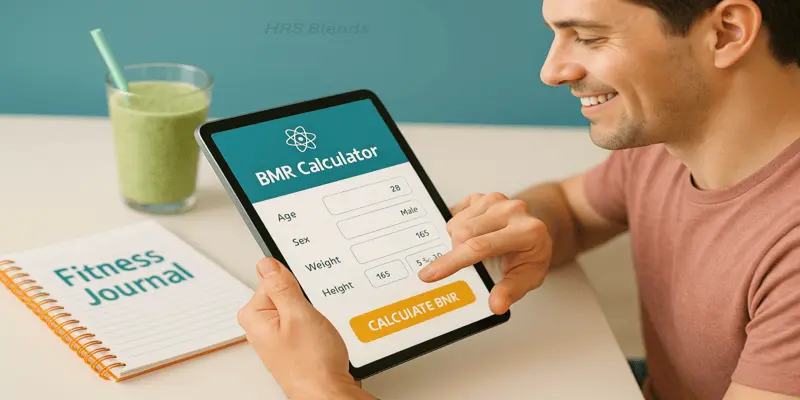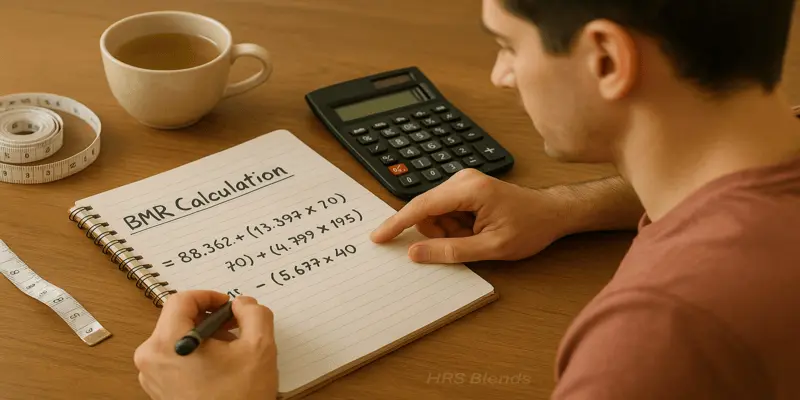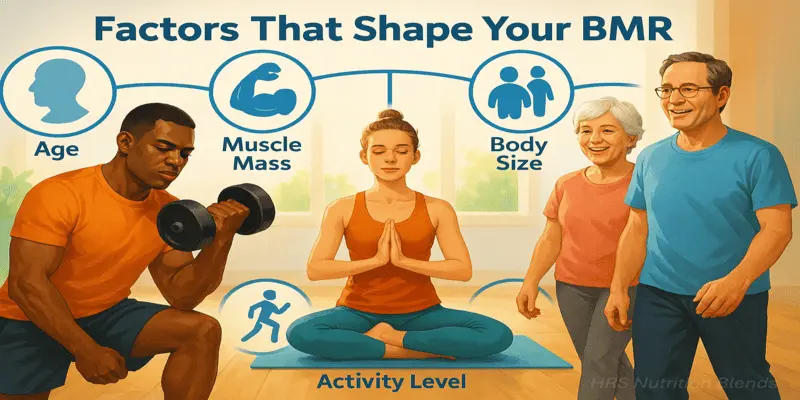Have you ever wondered why managing your weight can feel so puzzling? The uncertainty often stems from not understanding your body’s unique energy demands, quietly burned at rest. Learning to calculate BMR helps you discover your basal metabolic rate (BMR) – the energy your body uses for breathing, blood circulation, cell repair, and maintaining basic functions along with your daily calorie needs.
Over five years of coaching, I’ve assisted clients from various backgrounds across diverse regions to gain these insights. This comprehensive guide explains how to calculate BMR, covering manual methods, tool usage, influencing factors, common mistakes, and practical tips. For actionable applications, explore 7 Proven Ways to Achieve Weight Goals with a BMR Calculator next.
What is BMR and Why It Matters
BMR, or Basal Metabolic Rate, indicates the calories your body requires to perform essential functions like breathing, maintaining heart rate, regulating body temperature, and supporting cell regeneration while at complete rest. The Indian Council of Medical Research (ICMR) underscores the importance of knowing your BMR for crafting personalized nutrition strategies, a process made accessible by learning to calculate BMR. From my experience, I’ve witnessed a busy parent from a vibrant community shed 4 kg by aligning their diet with their BMR.

The National Institutes of Health (NIH) at https://www.nih.gov/health-information notes that misjudging calorie needs can lead to weight gain, exhaustion, or nutritional imbalances challenges I help clients navigate. Understanding your basal metabolic rate provides a foundational step toward informed health choices, offering valuable health insights into your body’s energy dynamics.
BMR vs TDEE: The Difference Explained
To fully leverage how to calculate BMR, it’s crucial to distinguish it from TDEE (Total Daily Energy Expenditure). Here’s a clear breakdown to guide you:
| Term | Meaning | Includes Activity? |
|---|---|---|
| BMR | Calories burned at rest | ❌ No |
| TDEE | Total calories burned daily | ✅ Yes |
BMR represents your baseline energy use without any physical activity, serving as the foundation of your daily calorie needs. TDEE, on the other hand, adds the extra calories burned through exercise, work, and everyday movements. I supported a retiree from a sunny region who learned to calculate BMR, determining a BMR of 1500 calories and a TDEE of 1800 calories, enabling them to adjust their eating habits effectively. This distinction is vital for interpreting your results when learning to calculate BMR.
Using a Tool to Calculate BMR for Instant Results
Uncover your basal metabolic rate and daily calorie needs by using our free tool to calculate BMR. Simply input your age, gender, weight, height, and activity level, and receive instant, tailored results that reflect your unique profile. This user-friendly resource eliminates guesswork, providing a reliable starting point for exploring your metabolic rate calculator.
For example, a student from an academic setting utilized the tool to calculate BMR and discovered their BMR was 1400 calories, which influenced their meal planning and dietary adjustments. Another client, a young athlete, found their rate at 1600 calories, helping them optimize their training diet. This resource serves as a seamless bridge to 7 Proven Ways to Achieve Weight Goals with a BMR Calculator for those ready to apply this knowledge.

Manual BMR Calculation Step-by-Step
While a tool to calculate BMR offers convenience, performing the computation manually using the Mifflin-St Jeor Equation can deepen your understanding and allow you to verify the tool’s results. Here’s the step-by-step process:
- For men:
BMR = 10 × weight (kg) + 6.25 × height (cm) − 5 × age (years) + 5 - For women:
BMR = 10 × weight (kg) + 6.25 × height (cm) − 5 × age (years) − 161
Example Calculation: Consider a 30-year-old man weighing 70 kg and standing 175 cm tall:
BMR = (10 × 70) + (6.25 × 175) − (5 × 30) + 5 = 700 + 1093.75 − 150 + 5 = 1648.75
BMR ≈ 1649 calories/day
A tech professional from a digital hub performed this calculation and cross-checked it with a tool to calculate BMR, confirming the accuracy of their calorie calculation. This method is particularly useful for those who enjoy a hands-on approach to tracking their daily calorie needs and health insights.

Factors That Shape Your BMR

Your basal metabolic rate, as determined by learning to calculate BMR, varies due to several key factors that can shift your daily calorie needs over time. Understanding these can help you interpret your results more effectively:
- Age – As you age, muscle mass naturally decreases, causing your energy use to decline gradually. This is why older adults often require fewer calories to maintain their weight.
- Gender – Men typically have a higher basal metabolic rate due to greater muscle mass compared to women, a difference that learning to calculate BMR can account for based on your input.
- Muscle Mass – Building muscle through regular strength training or resistance exercises can significantly boost your BMR, as muscle tissue burns more calories at rest than fat.
- Body Fat – Higher percentages of body fat can lower your BMR, making it important to monitor this factor with a tool to calculate BMR over time.
- Hormones – Thyroid hormones play a critical role; an overactive thyroid (hyperthyroidism) can increase your rate, while an underactive thyroid (hypothyroidism) may decrease it.
- Climate – Living in colder environments may slightly elevate your BMR as your body works harder to maintain its core temperature, a subtle effect worth noting.
For instance, a nurse from a rural area learned her low muscle mass was reducing her BMR, and we adjusted her fitness routine with guidance from a tool to calculate BMR to reflect this change. Another client, a teacher in a chilly region, noticed a slight uptick in their rate during winter months, highlighting how climate can play a role.
Common Mistakes to Avoid
Even when learning to calculate BMR, certain missteps can lead to inaccurate results, undermining your health insights:
- Ignoring Activity: Focusing solely on BMR without considering TDEE can mislead your understanding of total energy needs. A factory worker I coached adjusted this approach after initial confusion.
- Overestimating Exercise: Fitness trackers might overestimate calorie burn during workouts; I recommend cross-checking with manual inputs into a tool to calculate BMR.
- Skipping Updates: As your weight, muscle mass, or activity level changes, recalculating with a tool to calculate BMR is essential, as a farmer from a rainy area discovered after a season of hard labor.
- Outdated Formulas: Older equations like the Harris-Benedict can be less precise; the Mifflin-St Jeor method, supported by this tool, offers better accuracy for your calorie calculation.
Avoiding these pitfalls ensures your tool provides reliable data to guide your wellness journey.
Practical Tips for Using a Tool to Calculate BMR
To optimize your experience with a tool to calculate BMR and enhance the accuracy of your results, consider these practical tips:
- Measure Accurately: Use a reliable digital scale and a flexible tape measure for precise weight and height inputs to ensure your basal metabolic rate reflects your true state.
- Recalculate Regularly: Reassess your BMR every few months or after significant lifestyle changes, such as weight loss, muscle gain, or shifts in activity levels.
- Consult a Professional: If your results seem inconsistent or unusual, a dietitian or healthcare provider can help interpret your tool’s data in the context of your overall health.
- Track Trends: Keep a journal or digital log of your BMR over time to spot patterns, such as seasonal variations or progress from fitness goals, deepening your health insights.
These strategies can help you get the most out of your tool to calculate BMR, ensuring your daily calorie needs are well understood and applied effectively.
Final Insights
Uncovering your basal metabolic rate and daily calorie needs by learning to calculate BMR empowers you to manage your health proactively. This guide provides a thorough foundation for understanding your metabolic rate, from manual calculations to interpreting influencing factors and avoiding common errors. It sets the stage for 7 Proven Ways to Achieve Weight Goals with a BMR Calculator. Begin your journey with my BMR Calculator and explore my Wellness Starter Guide for additional resources to support your goals!
Frequently Asked Questions (FAQ)
Q1: How accurate is a BMR calculator?
BMR calculators give formula‑based estimates using your age, weight, height, and gender. They’re reliable for general guidance but not a substitute for clinical testing.
Q2: Do I need to adjust my BMR for exercise?
Yes. BMR is your resting calorie burn. To include activity, calculate your TDEE by multiplying BMR by an activity factor.
Q3: Can diet or exercise change my BMR?
Yes – building muscle can increase your BMR since muscle burns more calories at rest. Extreme calorie restriction can lower it over time.
Q4: Is BMR different for men and women?
Generally, men have a higher BMR due to greater muscle mass, but individual factors like body composition matter more.
Q5: How often should I recalculate my BMR?
Update it after major changes in weight, activity level, or muscle mass, or at least every 6–12 months.
Q6: What’s the best way to use my BMR for weight loss?
Find your TDEE, then create a calorie deficit of about 300–500 calories per day for gradual, sustainable fat loss.
Q7: Why might two people of the same size have different BMRs?
Differences in muscle mass, hormone levels, genetics, and lifestyle can cause variations even at the same height and weight.
Q8: Can climate affect my BMR?
Yes, living in colder climates can slightly raise your BMR as your body works harder to maintain core temperature.
Q9: Does sleeping more or less change my BMR?
Not directly, but poor sleep can affect hormones that influence metabolism and appetite.
Q10: What’s the quickest way to know my daily calorie needs?
Use a BMR calculator, then adjust for activity to get your TDEE — this gives your total daily calorie requirement.
Disclaimer: This is general advice from my coaching, not medical advice. Consult a doctor before making significant changes. I’m not liable for any issues arising from its use.
Next Read:
Best Effortless Indian Diet Plan
Resources:

I’m a passionate wellness coach with over 5 years of experience helping people build healthier lives through balanced nutrition and practical lifestyle habits. I focus on science-backed guidance, including whole foods, mindful eating, and smart protein choices, to support energy, digestion, and long-term well-being. My approach is flexible, realistic, and built on the belief that prevention is better than cure because lasting health starts with daily choices.

